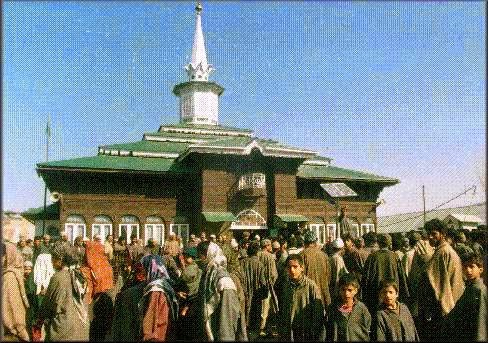Understanding Our Local Narratives
 Kashmiris
are famously charged with pir parasti. And this pir parasti is
associated with a host of beliefs and practices that we need to take
into account. The question is how to understand or engage with the local
narrative. Our dismissive rejection or wholesale embracing of this
narrative is what we are often supposed to choose in Kashmir. Given the
ideological polarization, and the often huge costs hidden in these
choices, we need to be better informed about what exactly constitutes
local narratives and how far one can wish it away if one chooses to.
Kashmiris
are famously charged with pir parasti. And this pir parasti is
associated with a host of beliefs and practices that we need to take
into account. The question is how to understand or engage with the local
narrative. Our dismissive rejection or wholesale embracing of this
narrative is what we are often supposed to choose in Kashmir. Given the
ideological polarization, and the often huge costs hidden in these
choices, we need to be better informed about what exactly constitutes
local narratives and how far one can wish it away if one chooses to.
Equally,
the Salafis and others who find some problems with the local narrative
need to come up with informed critique of a culture deeply affected by
this narrative. Such an informed analysis of this local narrative has
not been made by our historians or culture experts. And this means a lot
for people in search of self-identity in times that seek to fracture
such attempts. The space here won’t allow much, but here are a few
points.
Local
mystics are consulted by rulers and many life’s decisions are not taken
without such consultation. (There are family mystics as there are
family doctors in Kashmir.) Mystics can enter any home and are received
warmly and reverentially although in this guise many charlatans, and
even insane, carve a space or livelihood for themselves. Popular
proverbs like “In Adam’s skin are hidden great secrets” are often
invoked while the question of dismissing a claimant of mystical powers
arises. Mystics’ residences or shrines are thronged by all and sundry
including the educated elite and ruling class.
Almost
every other day there is some celebration commemorating some local
mystic’s urs. Many people claim to be in touch with their dead masters.
And every Thursday, there is mahfil e sama in many places. The most
visited spots happen to be the shrines. And many people before going for
their court hearings come to shrines to seek ‘blessings’. Almost every
person has a story to narrate of an encounter with a ‘realized’ soul or a
powerful mystic.
Here,
mystics are seen roaming naked in freezing winters while some hold a
fire pot in the midst of hot summers. Some have been noted to take so
little food that people are led to believe that they are fed by God. And
some are believed to share food with some otherworldly beings.
Childless couples seek the help of mystics and success stories galore!
And some children are well known in localities to be begotten by the
mystics’ prayer and almost consecrated to his memory and they receive
special treatment.
Mystics
have been seen publicly predicting downfall of governments resulting in
new elections and key figures of all ruling parties seek appointment
with them at key moments. And I have seen some mystics drawing maps of
roads that are yet to be built, claiming they are drawing the master
plans.
People
invoke traditional Sufi belief in the hierarchy of power that is
occupied by saints of different categories. The belief in the authority
of a mystic is so popular that all kinds of charlatans disguising
themselves as mystics loot people. Mysticism is sold as a commodity for
faith healing and a shortcut to worldly success and its traders are not
easily picked. Pseudo-mystics are everywhere contributing to a
decreasing reputation of mystics among newer generations.
Despite
strong theological criticisms of certain popular beliefs and practices
lately from the Salafis and Jamaat-i-Islami ideologues, the popularity
of the mystic cult and shrines and paraphernalia – prayer food culture,
loud recitations of mystical or devotional hymns, khatam and niyaz
parties – has not lost its sheen. Many families ‘invite’ the
11th-century Sufi Abdul Qadir Jeelani on the 11th of every month.
It
is not that mystics have failed to stamp their indelible prints in the
cultural consciousness of people. There are countless trees and stones
and springs whose special features are attributed to certain mystics.
Almost every locality has such miraculous relic. It seems that Hopkins’
statement that everything is charged with the grandeur of God is felt
with all its terrible reality here and captures an aspect of Kashmiri
perception of the world. It is considered a life’s treasure to find a
true Master in many Muslim communities and this is particularly true
about Kashmir. And in almost every locality there may be someone, famous
or hidden, who claims to be, or is thought to be, a Master.
Faith
healing is a big business and is an evidence of people’s faith in
mystics. Faith healing attributed to mystics is differentiated from the
one attributed to occultists. More accomplished mystics don’t resort to
amulets and other objects of the trade but just bless water, or cast a
glance, or even use ‘coded’ slangs to achieve their objectives.
And
people vie for the sputum, slaps or slangs of the mystics. Special
threads are tied in shrines for achieving particular objectives.
Children’s baby hair is mostly cut under the feet of some mystic buried
in some shrine. People throng to see relics of saints displayed on
special occasions at shrines. And people wish goodbye to near and dear
ones with the clause, “I leave you in the Pir’s custody.” These
constitute some aspects of the local narrative of mysticism in Kashmiri
culture.
Comments
Post a Comment